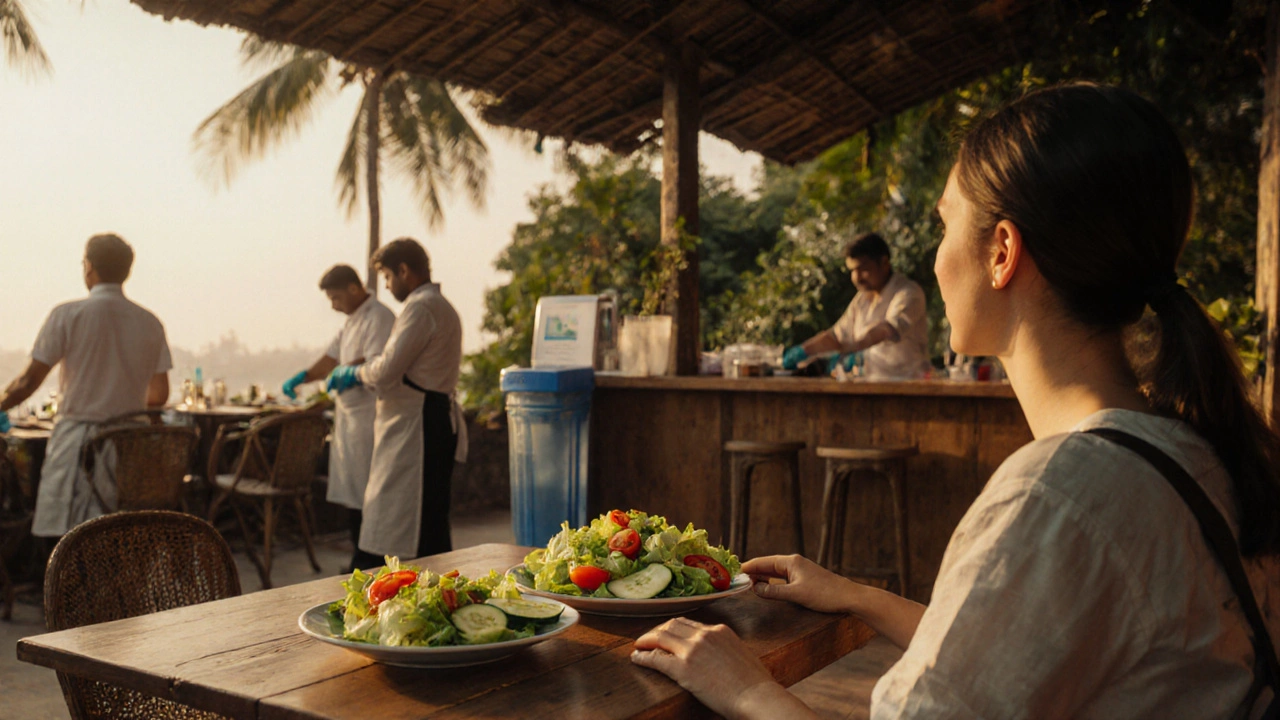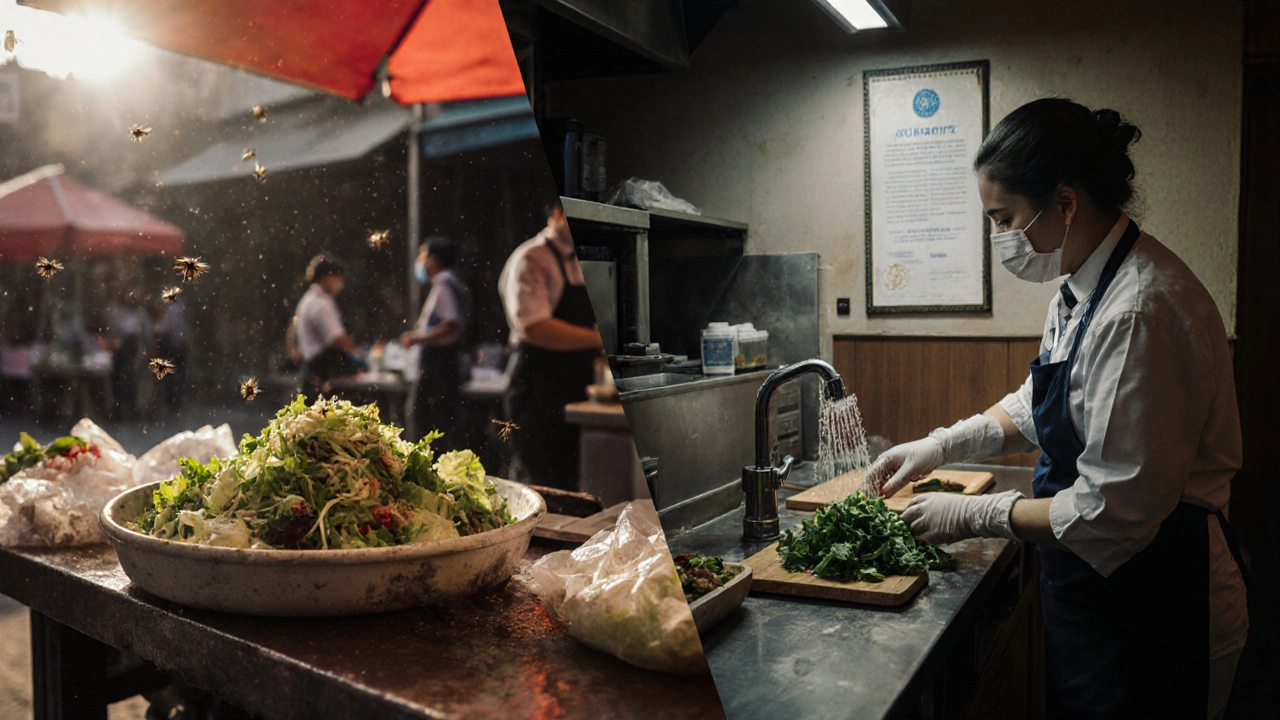Is It Safe to Eat Salad in India? A Traveler’s Practical Guide
 Nov, 21 2025
Nov, 21 2025
Salad Safety Checker
Is This Salad Safe?
Safety Assessment
You’re sitting under a thatched roof in Cochin, the sea breeze cooling your skin, a colorful plate of salad in front of you-crisp lettuce, sliced cucumber, cherry tomatoes, maybe even some fresh mint. It looks perfect. But then the question hits: Is it safe to eat salad in India? You’ve heard the warnings. You’ve seen travelers get sick. You don’t want to spend your vacation on the toilet.
The short answer? It’s possible to eat salad safely in India-but only if you know where, when, and how. This isn’t about avoiding salads altogether. It’s about making smart choices based on how the food is handled, where it’s sourced, and who’s preparing it.
Why Salads Raise Red Flags in India
India’s water quality varies wildly. In many places, tap water isn’t safe to drink, and that includes water used to wash produce. Vegetables like lettuce, spinach, and herbs are often rinsed in untreated water, which can carry harmful bacteria like E. coli, Salmonella, or Hepatitis A. In rural areas or small roadside stalls, there’s little to no access to clean water, let alone proper sanitation.
Temperature also plays a role. In places like Kerala or Tamil Nadu, where it’s hot and humid year-round, bacteria multiply fast. A salad left out for two hours in 30°C heat can become a breeding ground for pathogens. Even if the ingredients start clean, poor storage or handling can ruin everything.
That’s why travelers often get sick-not because the food is inherently dangerous, but because of inconsistent hygiene standards. It’s not about the salad itself. It’s about the system around it.
Where You Can Safely Eat Salad in South India
Not all salads are created equal. Some places take food safety seriously-and they’re easy to spot.
High-end hotels and resorts in cities like Bangalore, Mysore, and Pondicherry usually source their produce from certified farms. They use filtered or bottled water to wash vegetables, and staff wear gloves and use sanitized cutting boards. Many even display hygiene certifications on their walls. If you’re staying at a 4-star or 5-star hotel, eating their salad is low-risk.
Upmarket restaurants in tourist-heavy areas like Fort Kochi or Hampi’s better cafés also follow stricter protocols. Look for places that serve salads as part of a set menu with grilled meats or seafood. These places rely on repeat customers and online reviews-they can’t afford to get people sick.
Even some local cafés in college neighborhoods or expat hubs in Chennai or Coimbatore serve fresh, safe salads. These spots often use bottled water and have a regular customer base of locals who’d complain if something went wrong. Ask the server: "Is the vegetable washed with bottled water?" If they hesitate or say no, walk away.
What to Avoid
Steer clear of street-side stalls selling pre-cut salads in plastic containers. These are the biggest risk. No refrigeration. No clean water. No gloves. Just a pile of lettuce sitting in the sun while someone chops tomatoes with the same knife they used for onions.
Also avoid buffets where salad bowls sit out for hours. Even if the food looked fresh at first, by midday, it’s a bacterial playground. Same goes for hotel breakfast spreads where salads have been sitting under heat lamps for 4+ hours.
Don’t assume organic = safe. Organic produce might be grown without pesticides, but that doesn’t mean it was washed in clean water. In fact, organic farms in rural India often use well water or river water for irrigation and washing-both of which can be contaminated.

How to Make Salad Safe: 3 Simple Rules
You don’t need to be a food scientist to protect yourself. Just follow these three rules:
- Wash it yourself. If you buy loose greens from a market, rinse them in bottled water-preferably with a drop of food-grade chlorine solution (available at pharmacies). Let them air dry on a clean towel.
- Peel or cook it. Cucumbers, carrots, and radishes are safer if peeled. Cooking kills bacteria, so opt for stir-fried greens or lightly sautéed spinach instead of raw.
- Choose dry over wet. Salads with vinegar-based dressings (like lemon-tamarind or yogurt-based) are safer than those drowned in mayonnaise or oil. Acid helps kill bacteria. Avoid creamy dressings unless you know they were made fresh that day.
Many travelers carry small bottles of water purification tablets. A single tablet in a liter of water, left for 30 minutes, makes it safe for washing produce. It’s a cheap, lightweight tool that can save your trip.
What Local People Do
Indians don’t eat raw salads the way Westerners do. In most South Indian homes, vegetables are cooked-steamed, stir-fried, or boiled. Even when they serve raw vegetables, it’s usually just a few slices of onion or cucumber, eaten right away with meals.
Street vendors who sell fresh fruit? They’ll often peel it for you on the spot. That’s the model you want to copy: fresh, washed right before eating, and consumed immediately.
Ask a local: "What do you eat raw?" They’ll likely say: mangoes, bananas, coconuts. Not lettuce. That tells you something.

Real Traveler Stories
Emma, a teacher from Australia, got sick in Munnar after eating a salad at a guesthouse that looked clean. She didn’t know the owner used well water to wash the greens. She spent two days bedridden, missing her trek to Top Station.
On the other hand, Raj, a backpacker from Canada, ate salads daily in Pondicherry at a French-run café. He asked about the water source. They showed him their filtration system. He never got sick.
The difference wasn’t the salad. It was the knowledge.
What to Pack for Safe Eating
Here’s what to carry in your travel kit:
- Water purification tablets (like Aquatabs)
- Small bottle of food-safe disinfectant spray (for wiping cutting boards or fruit)
- Reusable cloth napkins (to dry washed produce)
- Pre-packaged salad kits from home (for the first few days while you adjust)
- Probiotic supplements (to support gut health during dietary changes)
These aren’t luxuries. They’re your insurance policy.
Final Verdict: Yes, But Be Smart
Is it safe to eat salad in India? Yes-if you’re selective. Avoid street stalls. Stick to places with visible hygiene practices. Wash your own greens if you’re unsure. Choose acidic dressings. Peel when you can. And always trust your gut-literally.
Salad isn’t the enemy. Poor food handling is. With a little awareness, you can enjoy fresh, crisp vegetables without risking your trip. South India’s food scene is too rich to miss out on just because of fear. Just don’t be careless.
Can I eat salad at street food stalls in South India?
It’s not recommended. Most street vendors don’t have access to clean water or refrigeration. Salads there are often washed in untreated water and left out in the heat, making them high-risk. Stick to cooked vegetables or fruits you can peel yourself.
Are hotel salads safe in India?
Generally, yes-if it’s a mid-range to luxury hotel. Most reputable hotels use filtered or bottled water to wash produce, store food at proper temperatures, and have staff trained in food safety. Look for hygiene certificates or ask the staff directly about their washing process.
Does lemon juice make salad safe?
Lemon juice helps reduce bacteria due to its acidity, but it doesn’t kill everything. A splash of lemon on a salad washed in dirty water won’t make it safe. Use it as a bonus layer of protection, not a substitute for clean water and proper handling.
What vegetables are safest to eat raw in India?
Fruits and vegetables you can peel yourself are safest: bananas, oranges, mangoes, papayas, cucumbers, and carrots. Avoid leafy greens like lettuce, spinach, and cabbage unless you’re certain they were washed in purified water.
Should I take probiotics before eating salad in India?
It’s a good idea. Probiotics can help your gut handle unfamiliar bacteria and reduce the risk of traveler’s diarrhea. Start taking them a few days before your trip and continue while you’re there. Look for strains like Lactobacillus rhamnosus GG or Saccharomyces boulardii.